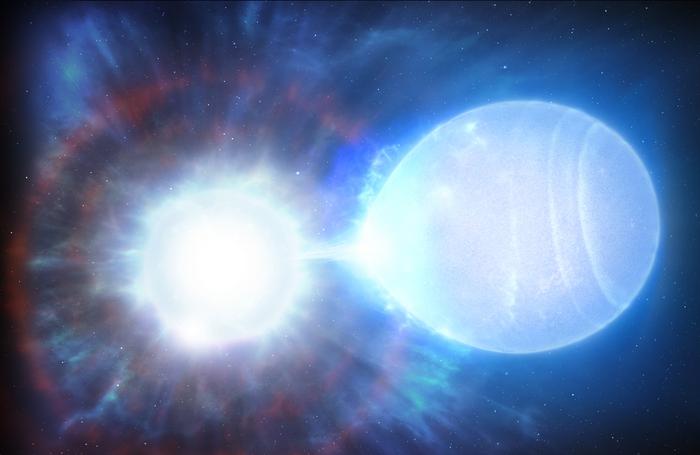In a groundbreaking discovery, astronomers from the University of Warwick have identified a rare and high mass binary star system located only about 150 light-years away from Earth. Named WDJ181058.67+311940.94, this extraordinary duo is on a path to collide and subsequently undergo a cataclysmic event known as a Type Ia supernova. This explosion is projected to be so luminous that, when it occurs, it could outshine the moon by tenfold in Earth’s night sky. Such supernovae are not merely cosmic spectacles; they hold profound significance in the realm of astrophysics, specifically in terms of measuring astronomical distances across the universe.
Type Ia supernovae are established as "standard candles," allowing astronomers to gauge distances between Earth and other galaxies. They occur under specific circumstances when a white dwarf, the dense remnant of a star, accumulates mass and surpasses its stability thresholds. Once the white dwarf reaches a critical mass, it succumbs to gravitational forces and explodes. The consensus among researchers has long suggested that most Type Ia supernovae arise from two closely orbiting white dwarfs. In this scenario, one star siphons material from its companion, ultimately resulting in an explosive end for both.
This recent discovery is revolutionary as it marks the first observation of such a binary system within our Milky Way galaxy. Details of the study have been published in the prestigious journal Nature Astronomy, further elevating the significance of this find. The lead researcher, James Munday, expressed his enthusiasm upon detecting the system, particularly noting its high total mass. This excitement is shared among the international team of astronomers who utilized some of the world’s most advanced optical telescopes to analyze the compact nature of the stellar pair.
Anchored by their close proximity, the two white dwarfs in this binary system are situated merely 1/60th the distance from Earth to the Sun. Munday and his colleagues believe they have unequivocally found the first compact white dwarf binary system that will inevitably lead to a Type Ia supernova explosion within a cosmic timeframe comparable to the universe’s own age. This discovery enables astronomers to account for a fraction of the Type Ia supernova rate within the Milky Way with greater certainty, effectively enhancing our understanding of stellar evolution.
The combined mass of the stellar duo is an astonishing 1.56 times that of our Sun. This high mass reinforces the conclusion that these stars are on an unavoidable path to explosion. However, astronomical timelines dictate that the event will not transpire for approximately 23 billion years. This distant future holds no immediate threat to Earth, illustrating how cosmic events unfold on their own schedules, often far beyond human lifespans.
As the stars orbit one another over an extensive period—taking more than 14 hours for a single complete turn—gravitational waves generated from their interaction will gradually draw them closer together. Ultimately, as the white dwarfs nears the critical moment of detonation, their orbits will accelerate, culminating in a rapid completion of a revolution in just 30 to 40 seconds. This compact binary system presents a quintessential example of the cosmic ballet performed by stellar bodies over billions of years.
Dr. Ingrid Pelisoli, an Assistant Professor at the University of Warwick and a contributor to the research, highlighted the broader implications of this find. She emphasized that discovering such a system in relative vicinity suggests that similar binaries may be more commonplace than previously thought. This discovery is just the beginning; ongoing surveys are still being conducted to identify additional Type Ia progenitors that may exist in our galaxy, and as the team continues their investigation, they anticipate more tantalizing discoveries.
The violence of a Type Ia supernova is unprecedented. As material transfers from one white dwarf to another, an intricate sequence unfolds leading to multiple detonations. The initial layer of the mass-gaining dwarf ignites first, followed by a subsequent explosion of its core. The debris from this explosion plays havoc with the other white dwarf, instigating a chain reaction that results in further detonations. The blast’s energy is so immense that it dwarfs even the largest nuclear explosions we can conceive, delivering a staggering amount of energy—about a thousand trillion trillion times that of the most powerful atomic bomb ever tested.
In the deep abyss of the future, as this supernova event approaches, it will emerge as a bright, scintillating point of light in night’s canvas, overshadowing even the most luminous celestial objects. Its brilliance will be monumental, set to shine up to ten times brighter than the moon and an astonishing 200,000 times brighter than Jupiter, rendering it an awe-inspiring spectacle for any future observers.
The implications of this discovery stretch beyond mere cosmic curiosity; they unravel new insights into the evolution of stars and the mechanics of the universe. Understanding such explosive events contributes significantly to our grasp of astrophysical processes and the life cycle of stars. As researchers like Munday and Pelisoli delve deeper into this phenomenon, future studies will illuminate further aspects of stellar dynamics and the cosmic events that govern the fate of galaxies.
As we look toward a distant future of cosmic explosions and stellar deaths, we reaffirm the majesty of the universe and its processes. Discoveries like this inspire awe and curiosity, fueling our persistent quest for knowledge about the cosmos and our place within it. The marriage of theory and observation in this case showcases the power of modern astronomy, revealing captivating stories of stars on the brink of explosive transformation.
Subject of Research: Not applicable
Article Title: A super-Chandrasekhar mass type Ia supernova progenitor at 49 pc set to detonate in 23 Gyr
News Publication Date: 4-Apr-2025
Web References: Nature Astronomy
References: Not applicable
Image Credits: University of Warwick/Mark Garlick
Keywords
Binary stars, Type Ia supernova, white dwarf, cosmic explosion, gravitational waves, astrophysics, astronomy, University of Warwick.




